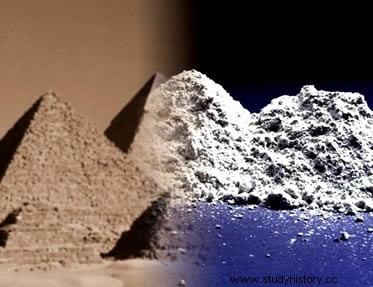
By Rainer Sousa
Today, engineering is undertaking increasingly surprising achievements. Through the use of various resources and the refinement of techniques, the possibilities of working with shapes and dimensions promote increasingly daring architectural constructions. However, for this to be possible, it was primordially necessary for man to invent something that could break the barriers imposed by the rudimentary constructions of clay and stone.
It was precisely because of the need for bolder constructions that cement ended up becoming one of the most important resources in the history of engineering. In short, cement is a fine powder with agglomeration properties, which hardens as soon as it comes into contact with water. Some researchers suppose that this type of material would have already been noticed by prehistoric man, when he noticed that the stones near the fires released a powder that hardened with the action of the serene.
One of the oldest evidences of the use of cement appears in the pyramids of Ancient Egypt. At that time, concerned with building the sumptuous pyramids, the Egyptians developed a type of cement made from a mixture of calcined gypsum. Among the Greeks, we noticed the use of volcanic earth that also hardened when mixed with water.
To build the Pantheon of Agrippa and the Coliseum, the Romans designed a slightly more sophisticated type of cement. Possibly Rome's urban builders developed a mixture of sand, pieces of tile, calcined limestone and volcanic ash. In fact, the information available on this tough mortar created by the Romans is minimal. The formula for Roman cement was such an important secret that it ended up disappearing with the dismantling of the empire itself.
Only in the 18th century, in the year 1758, this important material gained new characteristics again. On that date, the British engineer John Smeaton was given the task of developing a cement that could resist the erosive action of sea water. Using a volcanic ash from Italy, known as pozzolana, Smeaton manufactured an excellent quality cement that came to be used in the construction of the Eddystone Lighthouse, which lasted more than a century.
In the year 1796, another Briton named James Parker developed a new type of cement obtained by the calcination of nodules of impure limestone containing clay. After several tests carried out by other authorities on the subject, Parker cement, also known as Roman cement, was released for construction. As soon as he heard the news, James Parker sold the patent on his invention to members of the Wyatts, a traditional family of engineers and architects in England.
In 1824, Joseph Aspdin was responsible for the creation of the so-called “Portland Cement”, which referred to a British city that had excellent ore deposits used for cement. Building twelve meters long masonry furnaces in the shape of a bottle, Aspdin reached high temperatures that gave a higher quality to its cement.
Over time, new mixtures and the improvement of kilns led to the production of new types of cement. The systematic study of the mechanical and chemical mechanisms of cement paves the way for the construction industry to aim for new achievements. Currently, scholars involved in this type of research are looking for materials with greater strength and durability.
